Corporate Culture Module: Analyzing Export Strategies to China
VerifiedAdded on 2022/08/22
|9
|2375
|25
Report
AI Summary
This report delves into the multifaceted concept of corporate culture, exploring various theoretical frameworks and models, including clan, hierarchy, adhocracy, and market cultures. It examines the relationship between corporate and national culture, highlighting the influence of societal values and norms on organizational behavior. The core of the report analyzes Geert Hofstede's six cultural dimensions, such as power distance, individualism, masculinity, uncertainty avoidance, long-term orientation, and indulgence, and applies them to a real-world scenario: a marketing manager's challenges in exporting to China following Brexit. The analysis considers how each dimension impacts business practices, employee behavior, and the need for tailored strategies to navigate the Chinese market effectively, emphasizing the importance of understanding cultural nuances for international business success. The report underscores the significance of adapting to cultural differences to foster successful business ventures.
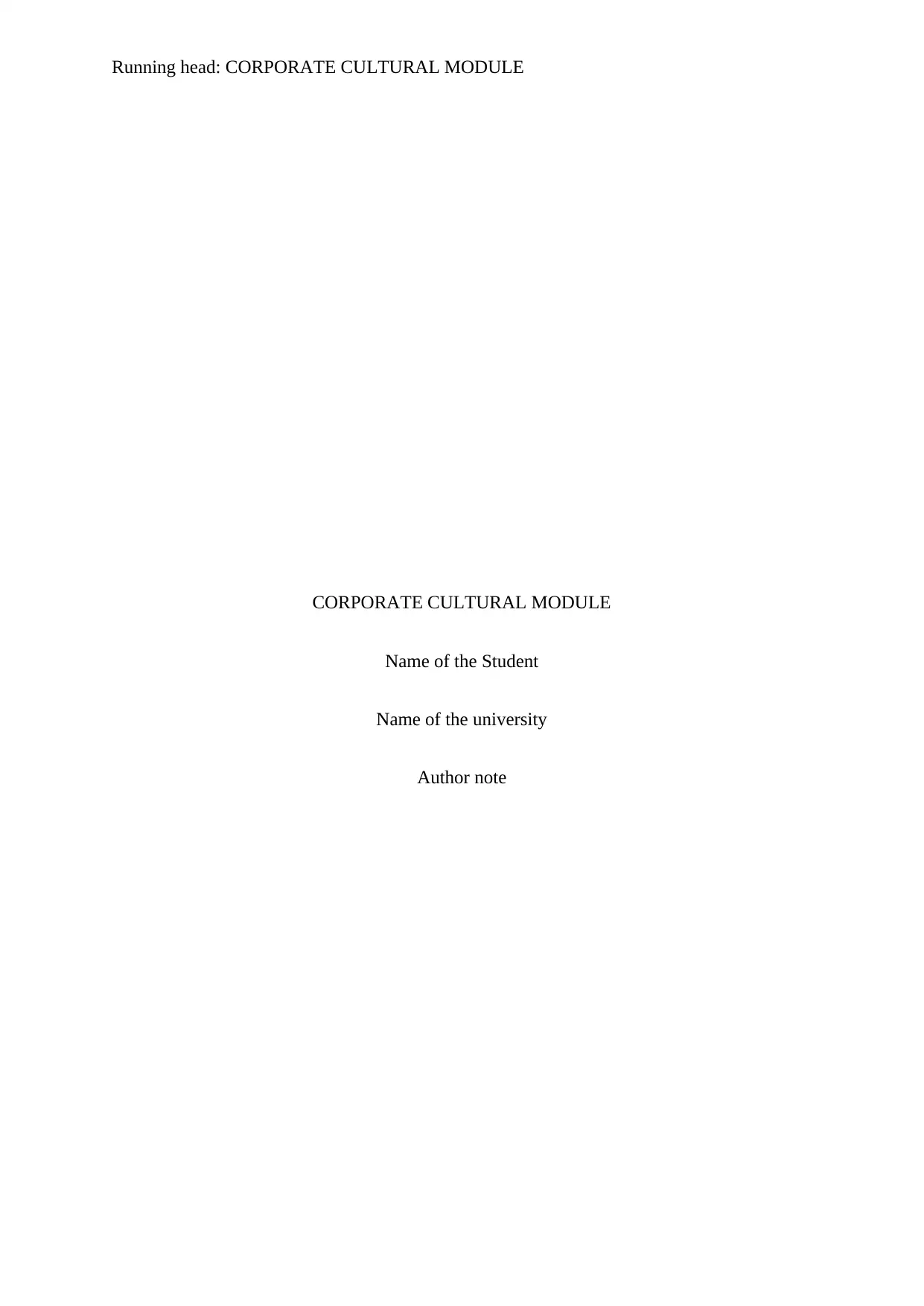
Running head: CORPORATE CULTURAL MODULE
CORPORATE CULTURAL MODULE
Name of the Student
Name of the university
Author note
CORPORATE CULTURAL MODULE
Name of the Student
Name of the university
Author note
Paraphrase This Document
Need a fresh take? Get an instant paraphrase of this document with our AI Paraphraser
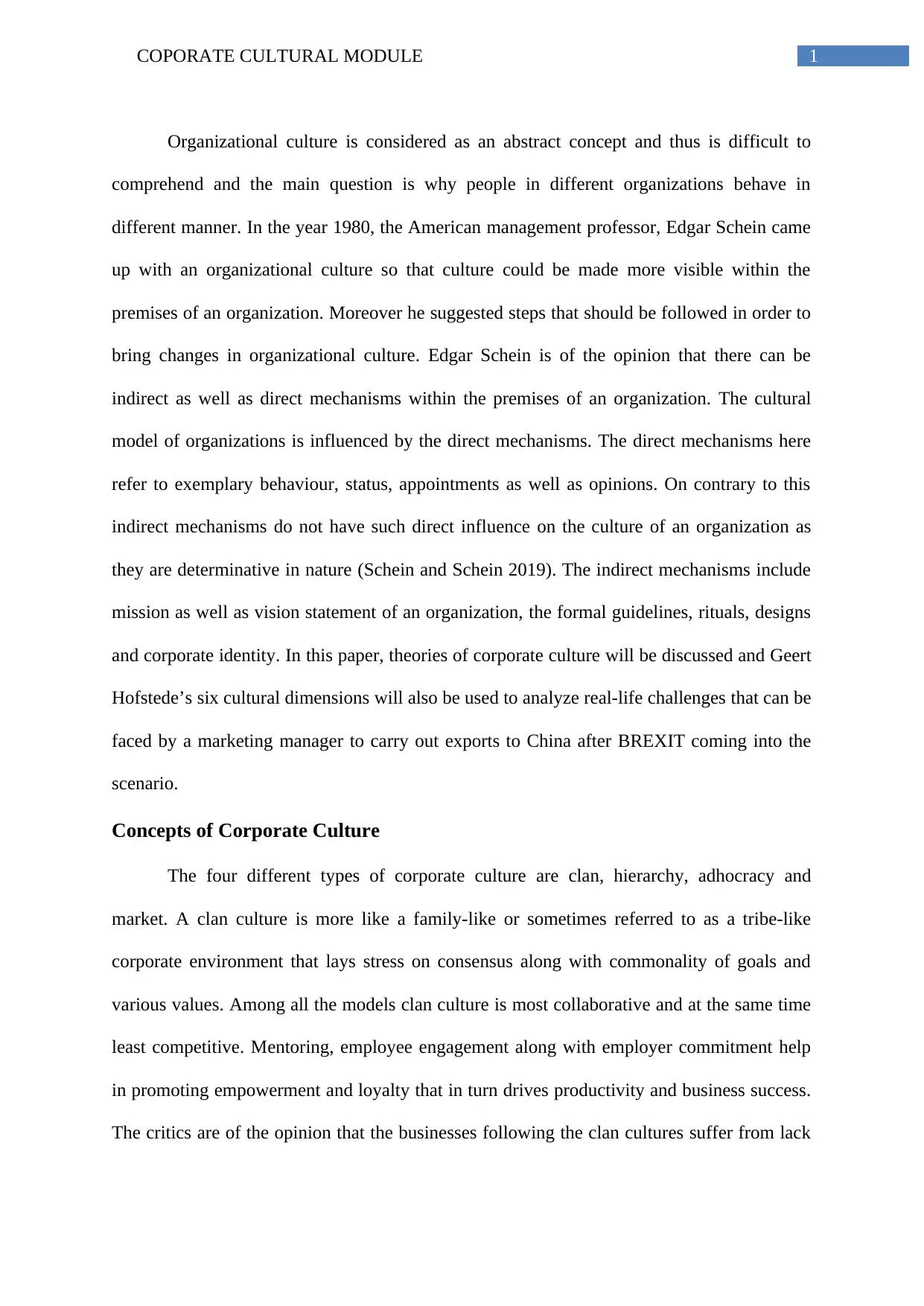
1COPORATE CULTURAL MODULE
Organizational culture is considered as an abstract concept and thus is difficult to
comprehend and the main question is why people in different organizations behave in
different manner. In the year 1980, the American management professor, Edgar Schein came
up with an organizational culture so that culture could be made more visible within the
premises of an organization. Moreover he suggested steps that should be followed in order to
bring changes in organizational culture. Edgar Schein is of the opinion that there can be
indirect as well as direct mechanisms within the premises of an organization. The cultural
model of organizations is influenced by the direct mechanisms. The direct mechanisms here
refer to exemplary behaviour, status, appointments as well as opinions. On contrary to this
indirect mechanisms do not have such direct influence on the culture of an organization as
they are determinative in nature (Schein and Schein 2019). The indirect mechanisms include
mission as well as vision statement of an organization, the formal guidelines, rituals, designs
and corporate identity. In this paper, theories of corporate culture will be discussed and Geert
Hofstede’s six cultural dimensions will also be used to analyze real-life challenges that can be
faced by a marketing manager to carry out exports to China after BREXIT coming into the
scenario.
Concepts of Corporate Culture
The four different types of corporate culture are clan, hierarchy, adhocracy and
market. A clan culture is more like a family-like or sometimes referred to as a tribe-like
corporate environment that lays stress on consensus along with commonality of goals and
various values. Among all the models clan culture is most collaborative and at the same time
least competitive. Mentoring, employee engagement along with employer commitment help
in promoting empowerment and loyalty that in turn drives productivity and business success.
The critics are of the opinion that the businesses following the clan cultures suffer from lack
Organizational culture is considered as an abstract concept and thus is difficult to
comprehend and the main question is why people in different organizations behave in
different manner. In the year 1980, the American management professor, Edgar Schein came
up with an organizational culture so that culture could be made more visible within the
premises of an organization. Moreover he suggested steps that should be followed in order to
bring changes in organizational culture. Edgar Schein is of the opinion that there can be
indirect as well as direct mechanisms within the premises of an organization. The cultural
model of organizations is influenced by the direct mechanisms. The direct mechanisms here
refer to exemplary behaviour, status, appointments as well as opinions. On contrary to this
indirect mechanisms do not have such direct influence on the culture of an organization as
they are determinative in nature (Schein and Schein 2019). The indirect mechanisms include
mission as well as vision statement of an organization, the formal guidelines, rituals, designs
and corporate identity. In this paper, theories of corporate culture will be discussed and Geert
Hofstede’s six cultural dimensions will also be used to analyze real-life challenges that can be
faced by a marketing manager to carry out exports to China after BREXIT coming into the
scenario.
Concepts of Corporate Culture
The four different types of corporate culture are clan, hierarchy, adhocracy and
market. A clan culture is more like a family-like or sometimes referred to as a tribe-like
corporate environment that lays stress on consensus along with commonality of goals and
various values. Among all the models clan culture is most collaborative and at the same time
least competitive. Mentoring, employee engagement along with employer commitment help
in promoting empowerment and loyalty that in turn drives productivity and business success.
The critics are of the opinion that the businesses following the clan cultures suffer from lack
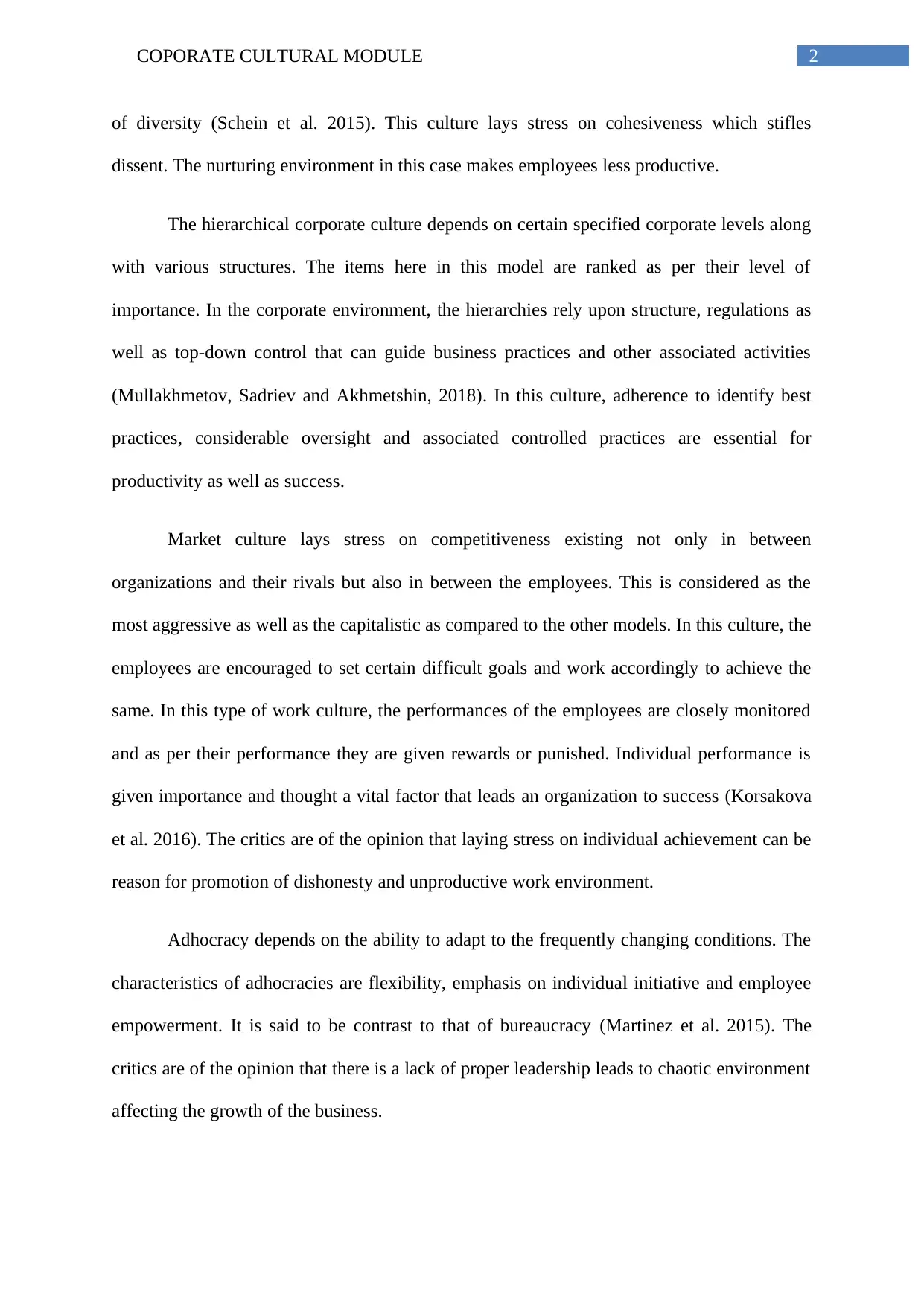
2COPORATE CULTURAL MODULE
of diversity (Schein et al. 2015). This culture lays stress on cohesiveness which stifles
dissent. The nurturing environment in this case makes employees less productive.
The hierarchical corporate culture depends on certain specified corporate levels along
with various structures. The items here in this model are ranked as per their level of
importance. In the corporate environment, the hierarchies rely upon structure, regulations as
well as top-down control that can guide business practices and other associated activities
(Mullakhmetov, Sadriev and Akhmetshin, 2018). In this culture, adherence to identify best
practices, considerable oversight and associated controlled practices are essential for
productivity as well as success.
Market culture lays stress on competitiveness existing not only in between
organizations and their rivals but also in between the employees. This is considered as the
most aggressive as well as the capitalistic as compared to the other models. In this culture, the
employees are encouraged to set certain difficult goals and work accordingly to achieve the
same. In this type of work culture, the performances of the employees are closely monitored
and as per their performance they are given rewards or punished. Individual performance is
given importance and thought a vital factor that leads an organization to success (Korsakova
et al. 2016). The critics are of the opinion that laying stress on individual achievement can be
reason for promotion of dishonesty and unproductive work environment.
Adhocracy depends on the ability to adapt to the frequently changing conditions. The
characteristics of adhocracies are flexibility, emphasis on individual initiative and employee
empowerment. It is said to be contrast to that of bureaucracy (Martinez et al. 2015). The
critics are of the opinion that there is a lack of proper leadership leads to chaotic environment
affecting the growth of the business.
of diversity (Schein et al. 2015). This culture lays stress on cohesiveness which stifles
dissent. The nurturing environment in this case makes employees less productive.
The hierarchical corporate culture depends on certain specified corporate levels along
with various structures. The items here in this model are ranked as per their level of
importance. In the corporate environment, the hierarchies rely upon structure, regulations as
well as top-down control that can guide business practices and other associated activities
(Mullakhmetov, Sadriev and Akhmetshin, 2018). In this culture, adherence to identify best
practices, considerable oversight and associated controlled practices are essential for
productivity as well as success.
Market culture lays stress on competitiveness existing not only in between
organizations and their rivals but also in between the employees. This is considered as the
most aggressive as well as the capitalistic as compared to the other models. In this culture, the
employees are encouraged to set certain difficult goals and work accordingly to achieve the
same. In this type of work culture, the performances of the employees are closely monitored
and as per their performance they are given rewards or punished. Individual performance is
given importance and thought a vital factor that leads an organization to success (Korsakova
et al. 2016). The critics are of the opinion that laying stress on individual achievement can be
reason for promotion of dishonesty and unproductive work environment.
Adhocracy depends on the ability to adapt to the frequently changing conditions. The
characteristics of adhocracies are flexibility, emphasis on individual initiative and employee
empowerment. It is said to be contrast to that of bureaucracy (Martinez et al. 2015). The
critics are of the opinion that there is a lack of proper leadership leads to chaotic environment
affecting the growth of the business.
⊘ This is a preview!⊘
Do you want full access?
Subscribe today to unlock all pages.

Trusted by 1+ million students worldwide
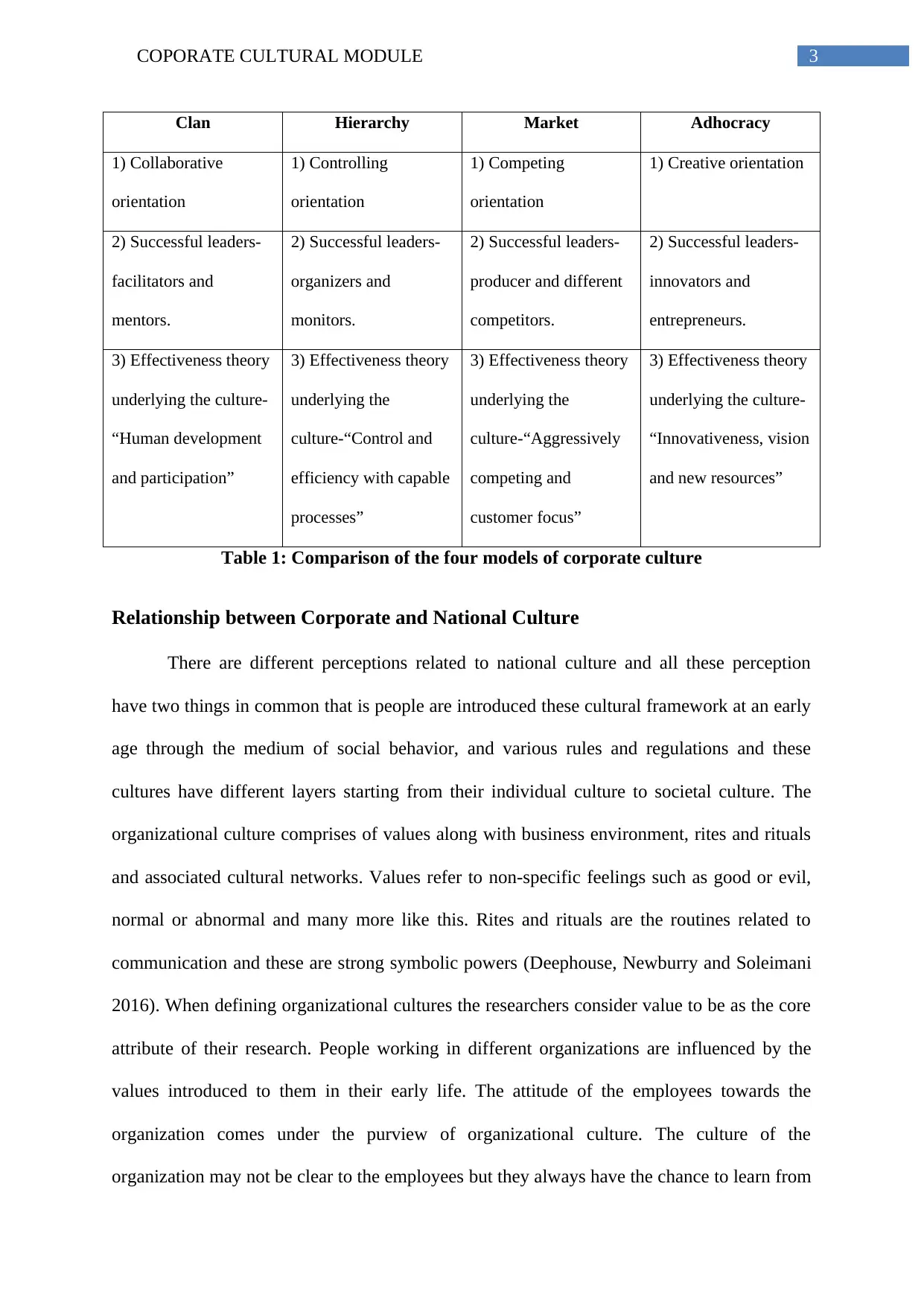
3COPORATE CULTURAL MODULE
Clan Hierarchy Market Adhocracy
1) Collaborative
orientation
1) Controlling
orientation
1) Competing
orientation
1) Creative orientation
2) Successful leaders-
facilitators and
mentors.
2) Successful leaders-
organizers and
monitors.
2) Successful leaders-
producer and different
competitors.
2) Successful leaders-
innovators and
entrepreneurs.
3) Effectiveness theory
underlying the culture-
“Human development
and participation”
3) Effectiveness theory
underlying the
culture-“Control and
efficiency with capable
processes”
3) Effectiveness theory
underlying the
culture-“Aggressively
competing and
customer focus”
3) Effectiveness theory
underlying the culture-
“Innovativeness, vision
and new resources”
Table 1: Comparison of the four models of corporate culture
Relationship between Corporate and National Culture
There are different perceptions related to national culture and all these perception
have two things in common that is people are introduced these cultural framework at an early
age through the medium of social behavior, and various rules and regulations and these
cultures have different layers starting from their individual culture to societal culture. The
organizational culture comprises of values along with business environment, rites and rituals
and associated cultural networks. Values refer to non-specific feelings such as good or evil,
normal or abnormal and many more like this. Rites and rituals are the routines related to
communication and these are strong symbolic powers (Deephouse, Newburry and Soleimani
2016). When defining organizational cultures the researchers consider value to be as the core
attribute of their research. People working in different organizations are influenced by the
values introduced to them in their early life. The attitude of the employees towards the
organization comes under the purview of organizational culture. The culture of the
organization may not be clear to the employees but they always have the chance to learn from
Clan Hierarchy Market Adhocracy
1) Collaborative
orientation
1) Controlling
orientation
1) Competing
orientation
1) Creative orientation
2) Successful leaders-
facilitators and
mentors.
2) Successful leaders-
organizers and
monitors.
2) Successful leaders-
producer and different
competitors.
2) Successful leaders-
innovators and
entrepreneurs.
3) Effectiveness theory
underlying the culture-
“Human development
and participation”
3) Effectiveness theory
underlying the
culture-“Control and
efficiency with capable
processes”
3) Effectiveness theory
underlying the
culture-“Aggressively
competing and
customer focus”
3) Effectiveness theory
underlying the culture-
“Innovativeness, vision
and new resources”
Table 1: Comparison of the four models of corporate culture
Relationship between Corporate and National Culture
There are different perceptions related to national culture and all these perception
have two things in common that is people are introduced these cultural framework at an early
age through the medium of social behavior, and various rules and regulations and these
cultures have different layers starting from their individual culture to societal culture. The
organizational culture comprises of values along with business environment, rites and rituals
and associated cultural networks. Values refer to non-specific feelings such as good or evil,
normal or abnormal and many more like this. Rites and rituals are the routines related to
communication and these are strong symbolic powers (Deephouse, Newburry and Soleimani
2016). When defining organizational cultures the researchers consider value to be as the core
attribute of their research. People working in different organizations are influenced by the
values introduced to them in their early life. The attitude of the employees towards the
organization comes under the purview of organizational culture. The culture of the
organization may not be clear to the employees but they always have the chance to learn from
Paraphrase This Document
Need a fresh take? Get an instant paraphrase of this document with our AI Paraphraser
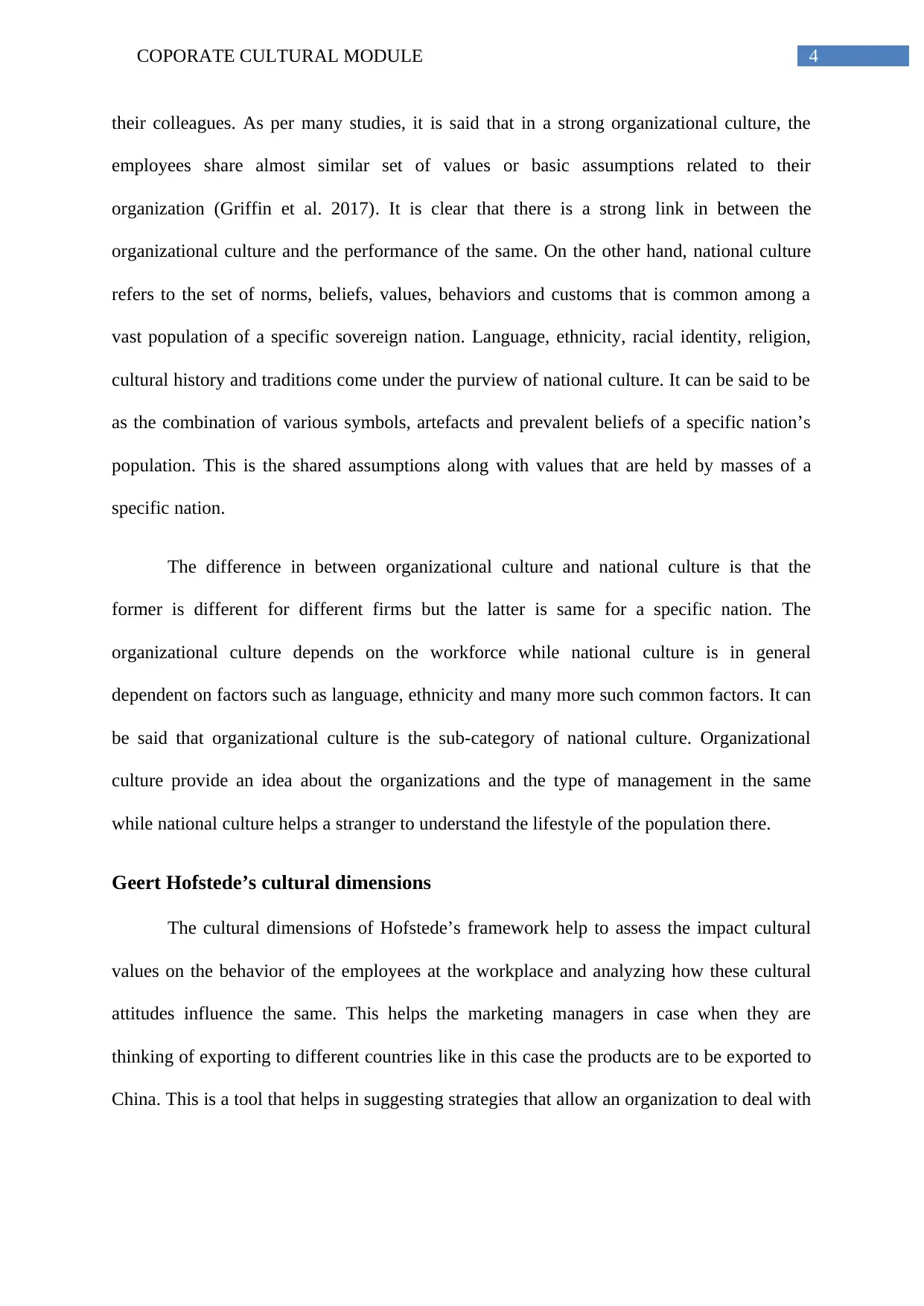
4COPORATE CULTURAL MODULE
their colleagues. As per many studies, it is said that in a strong organizational culture, the
employees share almost similar set of values or basic assumptions related to their
organization (Griffin et al. 2017). It is clear that there is a strong link in between the
organizational culture and the performance of the same. On the other hand, national culture
refers to the set of norms, beliefs, values, behaviors and customs that is common among a
vast population of a specific sovereign nation. Language, ethnicity, racial identity, religion,
cultural history and traditions come under the purview of national culture. It can be said to be
as the combination of various symbols, artefacts and prevalent beliefs of a specific nation’s
population. This is the shared assumptions along with values that are held by masses of a
specific nation.
The difference in between organizational culture and national culture is that the
former is different for different firms but the latter is same for a specific nation. The
organizational culture depends on the workforce while national culture is in general
dependent on factors such as language, ethnicity and many more such common factors. It can
be said that organizational culture is the sub-category of national culture. Organizational
culture provide an idea about the organizations and the type of management in the same
while national culture helps a stranger to understand the lifestyle of the population there.
Geert Hofstede’s cultural dimensions
The cultural dimensions of Hofstede’s framework help to assess the impact cultural
values on the behavior of the employees at the workplace and analyzing how these cultural
attitudes influence the same. This helps the marketing managers in case when they are
thinking of exporting to different countries like in this case the products are to be exported to
China. This is a tool that helps in suggesting strategies that allow an organization to deal with
their colleagues. As per many studies, it is said that in a strong organizational culture, the
employees share almost similar set of values or basic assumptions related to their
organization (Griffin et al. 2017). It is clear that there is a strong link in between the
organizational culture and the performance of the same. On the other hand, national culture
refers to the set of norms, beliefs, values, behaviors and customs that is common among a
vast population of a specific sovereign nation. Language, ethnicity, racial identity, religion,
cultural history and traditions come under the purview of national culture. It can be said to be
as the combination of various symbols, artefacts and prevalent beliefs of a specific nation’s
population. This is the shared assumptions along with values that are held by masses of a
specific nation.
The difference in between organizational culture and national culture is that the
former is different for different firms but the latter is same for a specific nation. The
organizational culture depends on the workforce while national culture is in general
dependent on factors such as language, ethnicity and many more such common factors. It can
be said that organizational culture is the sub-category of national culture. Organizational
culture provide an idea about the organizations and the type of management in the same
while national culture helps a stranger to understand the lifestyle of the population there.
Geert Hofstede’s cultural dimensions
The cultural dimensions of Hofstede’s framework help to assess the impact cultural
values on the behavior of the employees at the workplace and analyzing how these cultural
attitudes influence the same. This helps the marketing managers in case when they are
thinking of exporting to different countries like in this case the products are to be exported to
China. This is a tool that helps in suggesting strategies that allow an organization to deal with
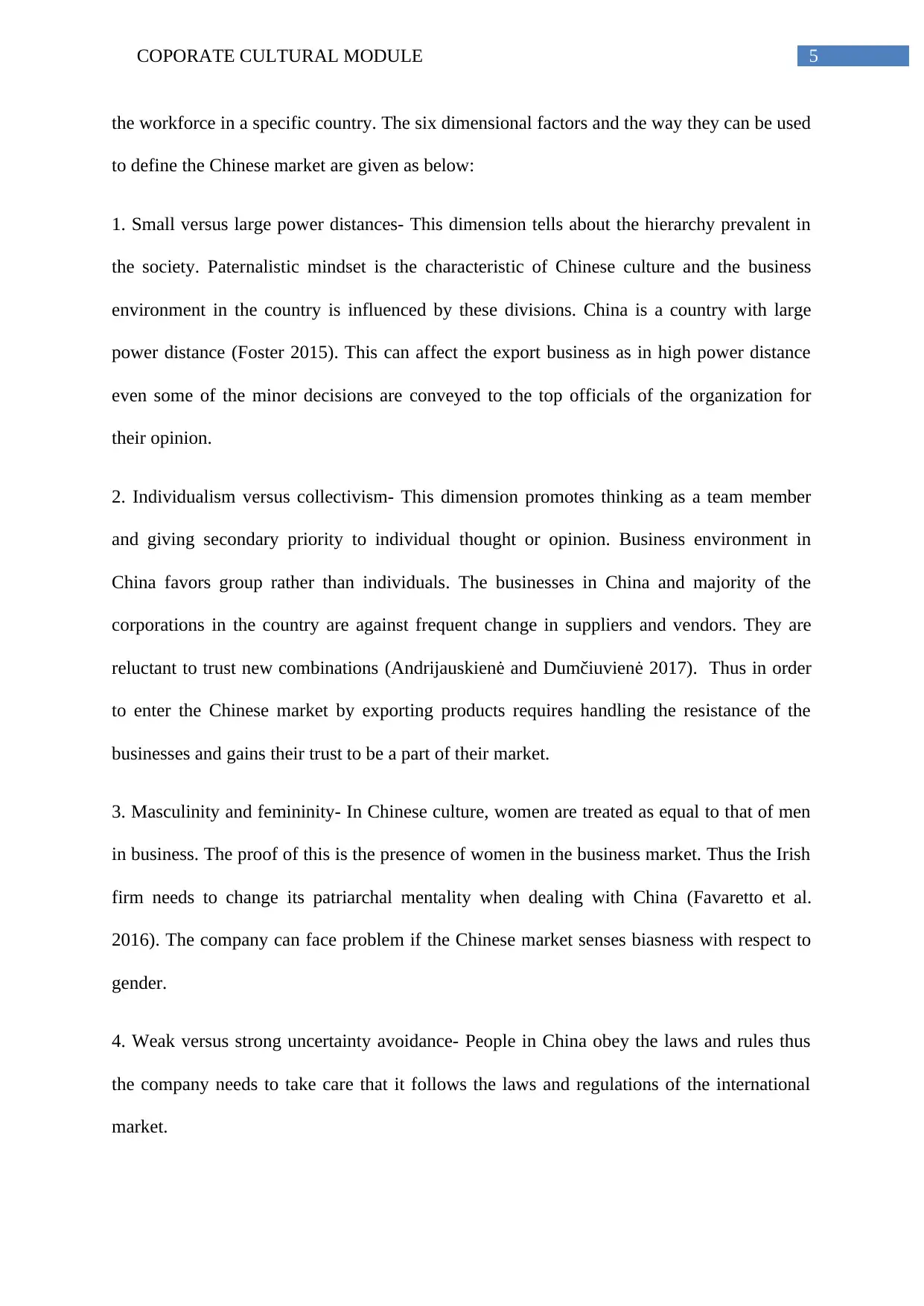
5COPORATE CULTURAL MODULE
the workforce in a specific country. The six dimensional factors and the way they can be used
to define the Chinese market are given as below:
1. Small versus large power distances- This dimension tells about the hierarchy prevalent in
the society. Paternalistic mindset is the characteristic of Chinese culture and the business
environment in the country is influenced by these divisions. China is a country with large
power distance (Foster 2015). This can affect the export business as in high power distance
even some of the minor decisions are conveyed to the top officials of the organization for
their opinion.
2. Individualism versus collectivism- This dimension promotes thinking as a team member
and giving secondary priority to individual thought or opinion. Business environment in
China favors group rather than individuals. The businesses in China and majority of the
corporations in the country are against frequent change in suppliers and vendors. They are
reluctant to trust new combinations (Andrijauskienė and Dumčiuvienė 2017). Thus in order
to enter the Chinese market by exporting products requires handling the resistance of the
businesses and gains their trust to be a part of their market.
3. Masculinity and femininity- In Chinese culture, women are treated as equal to that of men
in business. The proof of this is the presence of women in the business market. Thus the Irish
firm needs to change its patriarchal mentality when dealing with China (Favaretto et al.
2016). The company can face problem if the Chinese market senses biasness with respect to
gender.
4. Weak versus strong uncertainty avoidance- People in China obey the laws and rules thus
the company needs to take care that it follows the laws and regulations of the international
market.
the workforce in a specific country. The six dimensional factors and the way they can be used
to define the Chinese market are given as below:
1. Small versus large power distances- This dimension tells about the hierarchy prevalent in
the society. Paternalistic mindset is the characteristic of Chinese culture and the business
environment in the country is influenced by these divisions. China is a country with large
power distance (Foster 2015). This can affect the export business as in high power distance
even some of the minor decisions are conveyed to the top officials of the organization for
their opinion.
2. Individualism versus collectivism- This dimension promotes thinking as a team member
and giving secondary priority to individual thought or opinion. Business environment in
China favors group rather than individuals. The businesses in China and majority of the
corporations in the country are against frequent change in suppliers and vendors. They are
reluctant to trust new combinations (Andrijauskienė and Dumčiuvienė 2017). Thus in order
to enter the Chinese market by exporting products requires handling the resistance of the
businesses and gains their trust to be a part of their market.
3. Masculinity and femininity- In Chinese culture, women are treated as equal to that of men
in business. The proof of this is the presence of women in the business market. Thus the Irish
firm needs to change its patriarchal mentality when dealing with China (Favaretto et al.
2016). The company can face problem if the Chinese market senses biasness with respect to
gender.
4. Weak versus strong uncertainty avoidance- People in China obey the laws and rules thus
the company needs to take care that it follows the laws and regulations of the international
market.
⊘ This is a preview!⊘
Do you want full access?
Subscribe today to unlock all pages.

Trusted by 1+ million students worldwide
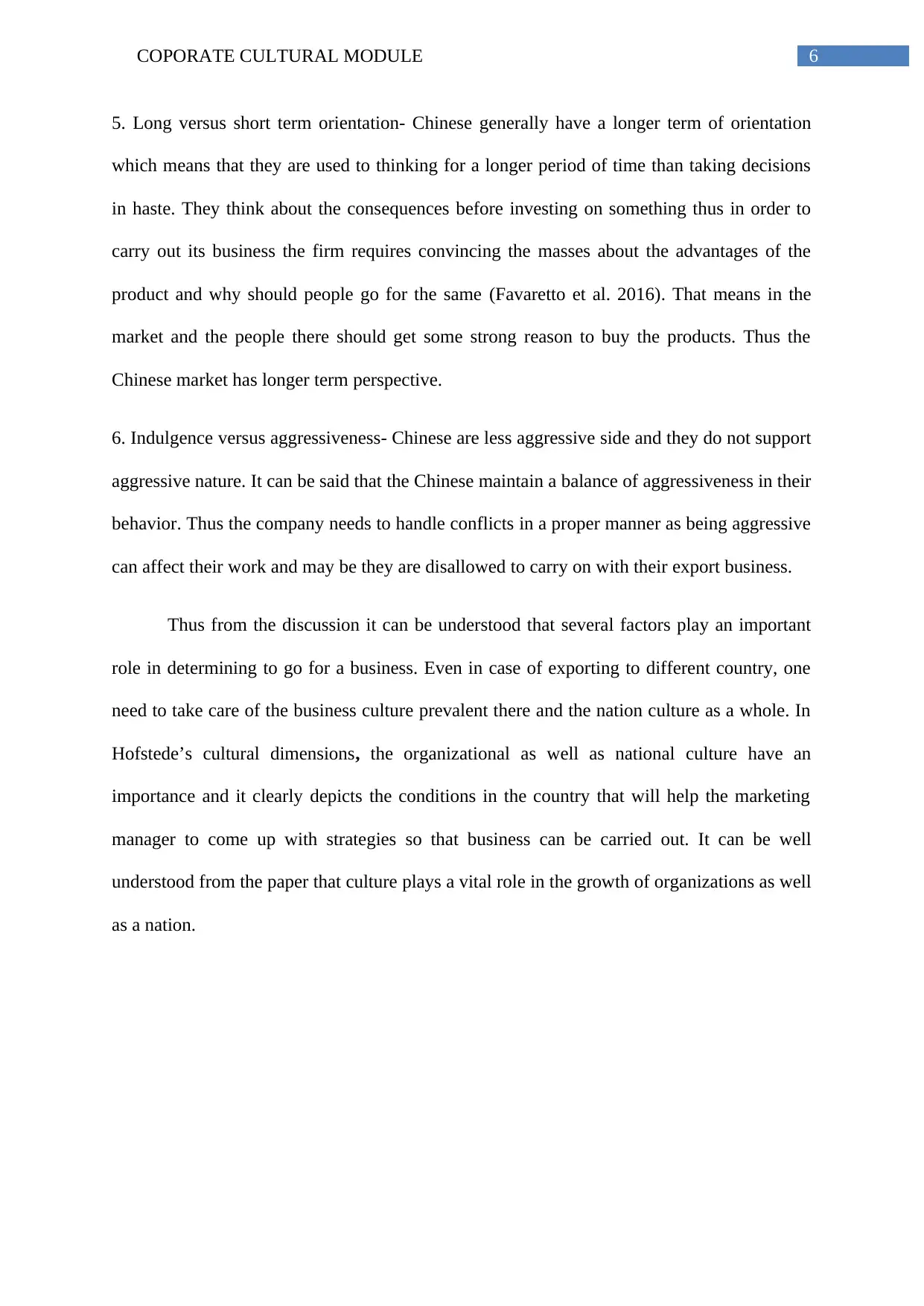
6COPORATE CULTURAL MODULE
5. Long versus short term orientation- Chinese generally have a longer term of orientation
which means that they are used to thinking for a longer period of time than taking decisions
in haste. They think about the consequences before investing on something thus in order to
carry out its business the firm requires convincing the masses about the advantages of the
product and why should people go for the same (Favaretto et al. 2016). That means in the
market and the people there should get some strong reason to buy the products. Thus the
Chinese market has longer term perspective.
6. Indulgence versus aggressiveness- Chinese are less aggressive side and they do not support
aggressive nature. It can be said that the Chinese maintain a balance of aggressiveness in their
behavior. Thus the company needs to handle conflicts in a proper manner as being aggressive
can affect their work and may be they are disallowed to carry on with their export business.
Thus from the discussion it can be understood that several factors play an important
role in determining to go for a business. Even in case of exporting to different country, one
need to take care of the business culture prevalent there and the nation culture as a whole. In
Hofstede’s cultural dimensions, the organizational as well as national culture have an
importance and it clearly depicts the conditions in the country that will help the marketing
manager to come up with strategies so that business can be carried out. It can be well
understood from the paper that culture plays a vital role in the growth of organizations as well
as a nation.
5. Long versus short term orientation- Chinese generally have a longer term of orientation
which means that they are used to thinking for a longer period of time than taking decisions
in haste. They think about the consequences before investing on something thus in order to
carry out its business the firm requires convincing the masses about the advantages of the
product and why should people go for the same (Favaretto et al. 2016). That means in the
market and the people there should get some strong reason to buy the products. Thus the
Chinese market has longer term perspective.
6. Indulgence versus aggressiveness- Chinese are less aggressive side and they do not support
aggressive nature. It can be said that the Chinese maintain a balance of aggressiveness in their
behavior. Thus the company needs to handle conflicts in a proper manner as being aggressive
can affect their work and may be they are disallowed to carry on with their export business.
Thus from the discussion it can be understood that several factors play an important
role in determining to go for a business. Even in case of exporting to different country, one
need to take care of the business culture prevalent there and the nation culture as a whole. In
Hofstede’s cultural dimensions, the organizational as well as national culture have an
importance and it clearly depicts the conditions in the country that will help the marketing
manager to come up with strategies so that business can be carried out. It can be well
understood from the paper that culture plays a vital role in the growth of organizations as well
as a nation.
Paraphrase This Document
Need a fresh take? Get an instant paraphrase of this document with our AI Paraphraser
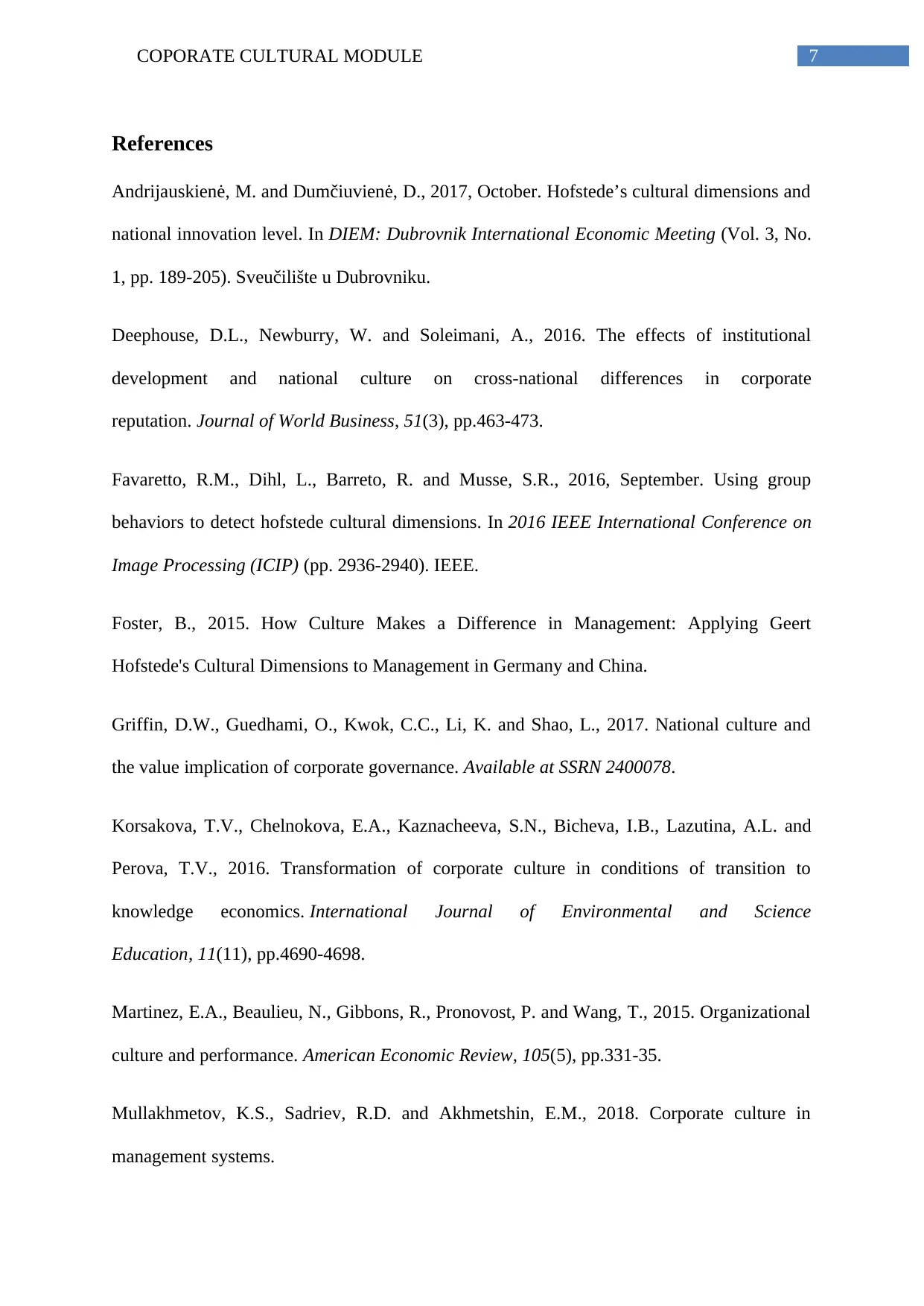
7COPORATE CULTURAL MODULE
References
Andrijauskienė, M. and Dumčiuvienė, D., 2017, October. Hofstede’s cultural dimensions and
national innovation level. In DIEM: Dubrovnik International Economic Meeting (Vol. 3, No.
1, pp. 189-205). Sveučilište u Dubrovniku.
Deephouse, D.L., Newburry, W. and Soleimani, A., 2016. The effects of institutional
development and national culture on cross-national differences in corporate
reputation. Journal of World Business, 51(3), pp.463-473.
Favaretto, R.M., Dihl, L., Barreto, R. and Musse, S.R., 2016, September. Using group
behaviors to detect hofstede cultural dimensions. In 2016 IEEE International Conference on
Image Processing (ICIP) (pp. 2936-2940). IEEE.
Foster, B., 2015. How Culture Makes a Difference in Management: Applying Geert
Hofstede's Cultural Dimensions to Management in Germany and China.
Griffin, D.W., Guedhami, O., Kwok, C.C., Li, K. and Shao, L., 2017. National culture and
the value implication of corporate governance. Available at SSRN 2400078.
Korsakova, T.V., Chelnokova, E.A., Kaznacheeva, S.N., Bicheva, I.B., Lazutina, A.L. and
Perova, T.V., 2016. Transformation of corporate culture in conditions of transition to
knowledge economics. International Journal of Environmental and Science
Education, 11(11), pp.4690-4698.
Martinez, E.A., Beaulieu, N., Gibbons, R., Pronovost, P. and Wang, T., 2015. Organizational
culture and performance. American Economic Review, 105(5), pp.331-35.
Mullakhmetov, K.S., Sadriev, R.D. and Akhmetshin, E.M., 2018. Corporate culture in
management systems.
References
Andrijauskienė, M. and Dumčiuvienė, D., 2017, October. Hofstede’s cultural dimensions and
national innovation level. In DIEM: Dubrovnik International Economic Meeting (Vol. 3, No.
1, pp. 189-205). Sveučilište u Dubrovniku.
Deephouse, D.L., Newburry, W. and Soleimani, A., 2016. The effects of institutional
development and national culture on cross-national differences in corporate
reputation. Journal of World Business, 51(3), pp.463-473.
Favaretto, R.M., Dihl, L., Barreto, R. and Musse, S.R., 2016, September. Using group
behaviors to detect hofstede cultural dimensions. In 2016 IEEE International Conference on
Image Processing (ICIP) (pp. 2936-2940). IEEE.
Foster, B., 2015. How Culture Makes a Difference in Management: Applying Geert
Hofstede's Cultural Dimensions to Management in Germany and China.
Griffin, D.W., Guedhami, O., Kwok, C.C., Li, K. and Shao, L., 2017. National culture and
the value implication of corporate governance. Available at SSRN 2400078.
Korsakova, T.V., Chelnokova, E.A., Kaznacheeva, S.N., Bicheva, I.B., Lazutina, A.L. and
Perova, T.V., 2016. Transformation of corporate culture in conditions of transition to
knowledge economics. International Journal of Environmental and Science
Education, 11(11), pp.4690-4698.
Martinez, E.A., Beaulieu, N., Gibbons, R., Pronovost, P. and Wang, T., 2015. Organizational
culture and performance. American Economic Review, 105(5), pp.331-35.
Mullakhmetov, K.S., Sadriev, R.D. and Akhmetshin, E.M., 2018. Corporate culture in
management systems.
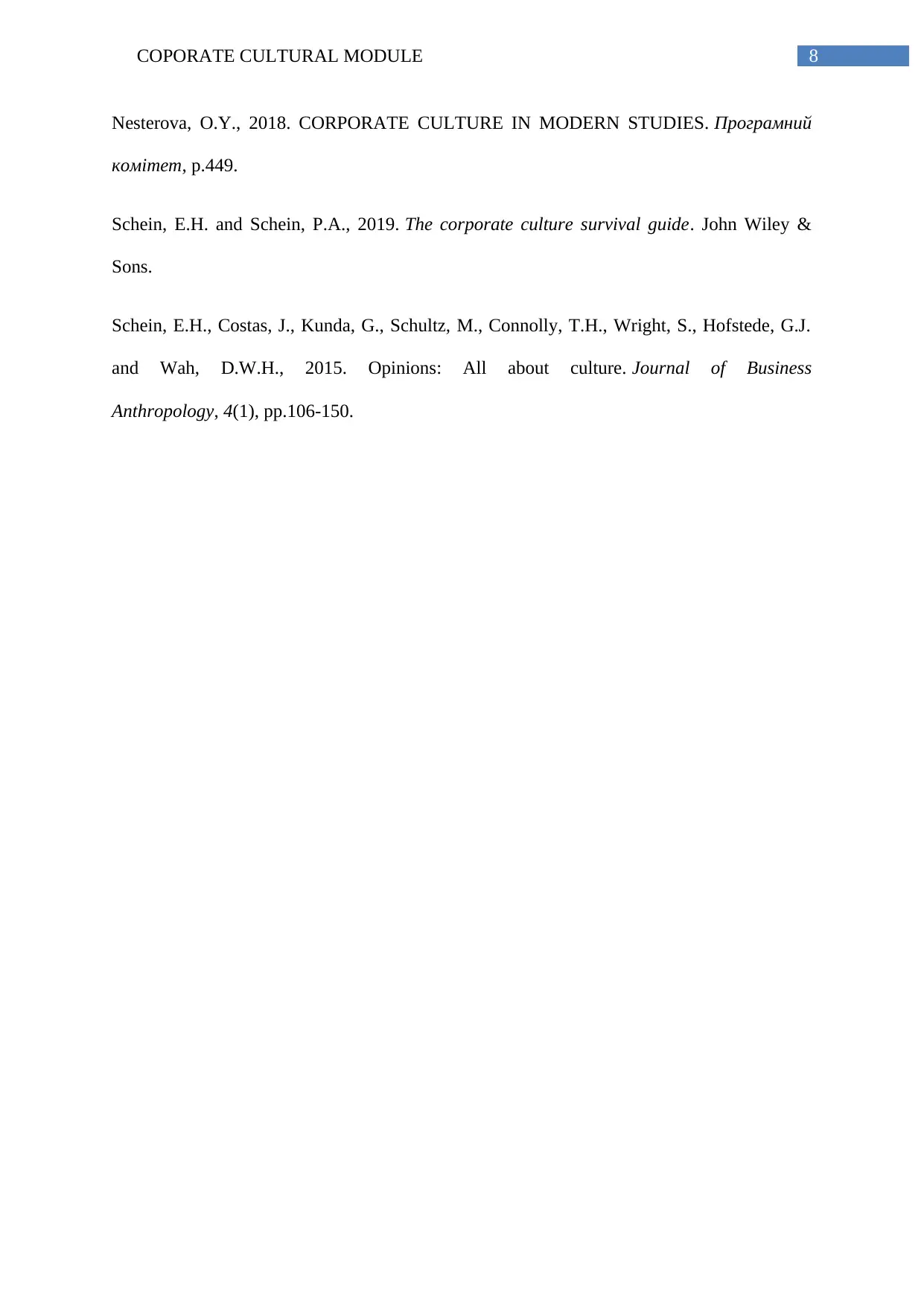
8COPORATE CULTURAL MODULE
Nesterova, O.Y., 2018. CORPORATE CULTURE IN MODERN STUDIES. Програмний
комітет, p.449.
Schein, E.H. and Schein, P.A., 2019. The corporate culture survival guide. John Wiley &
Sons.
Schein, E.H., Costas, J., Kunda, G., Schultz, M., Connolly, T.H., Wright, S., Hofstede, G.J.
and Wah, D.W.H., 2015. Opinions: All about culture. Journal of Business
Anthropology, 4(1), pp.106-150.
Nesterova, O.Y., 2018. CORPORATE CULTURE IN MODERN STUDIES. Програмний
комітет, p.449.
Schein, E.H. and Schein, P.A., 2019. The corporate culture survival guide. John Wiley &
Sons.
Schein, E.H., Costas, J., Kunda, G., Schultz, M., Connolly, T.H., Wright, S., Hofstede, G.J.
and Wah, D.W.H., 2015. Opinions: All about culture. Journal of Business
Anthropology, 4(1), pp.106-150.
⊘ This is a preview!⊘
Do you want full access?
Subscribe today to unlock all pages.

Trusted by 1+ million students worldwide
1 out of 9
Related Documents
Your All-in-One AI-Powered Toolkit for Academic Success.
+13062052269
info@desklib.com
Available 24*7 on WhatsApp / Email
![[object Object]](/_next/static/media/star-bottom.7253800d.svg)
Unlock your academic potential
Copyright © 2020–2025 A2Z Services. All Rights Reserved. Developed and managed by ZUCOL.




